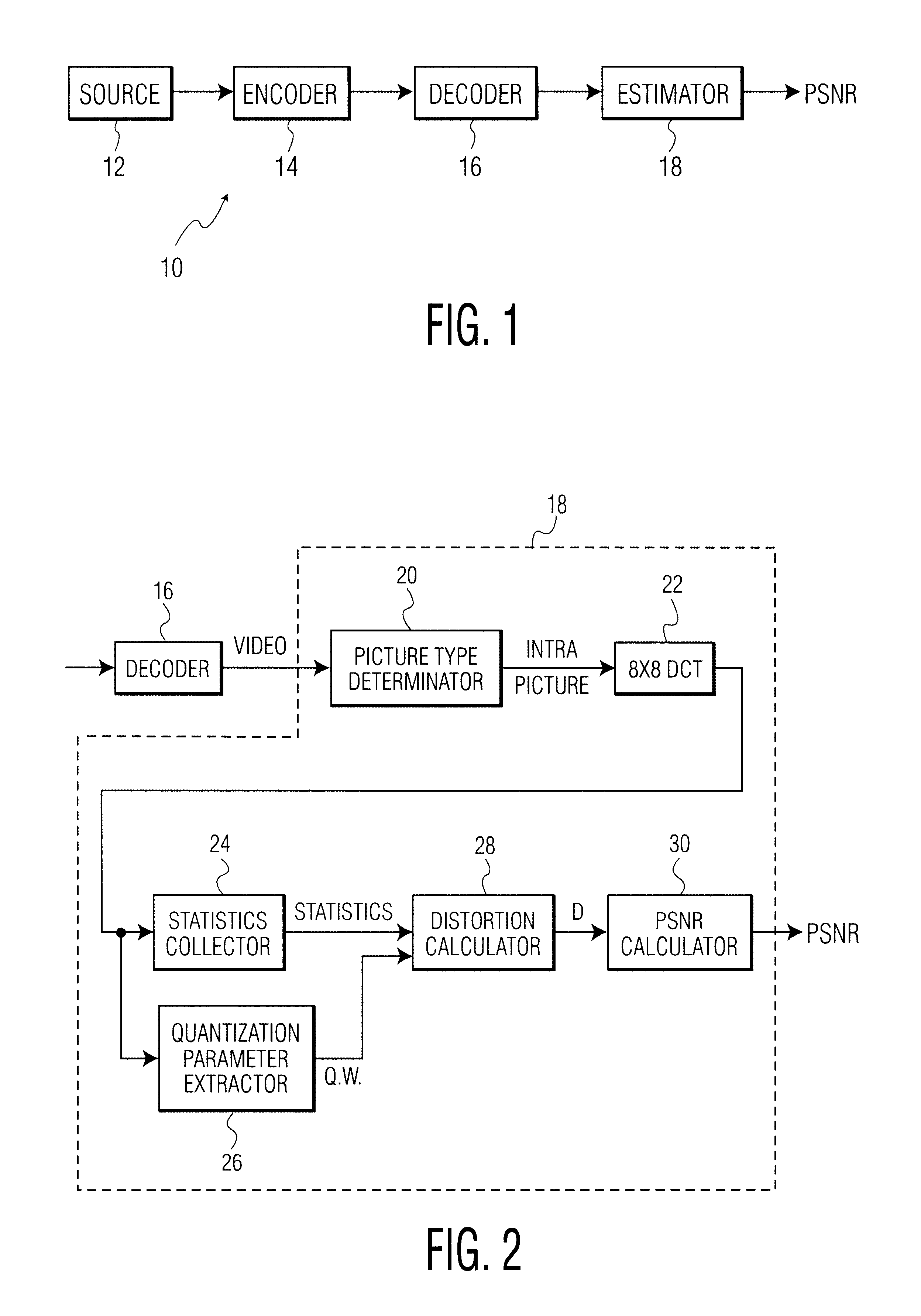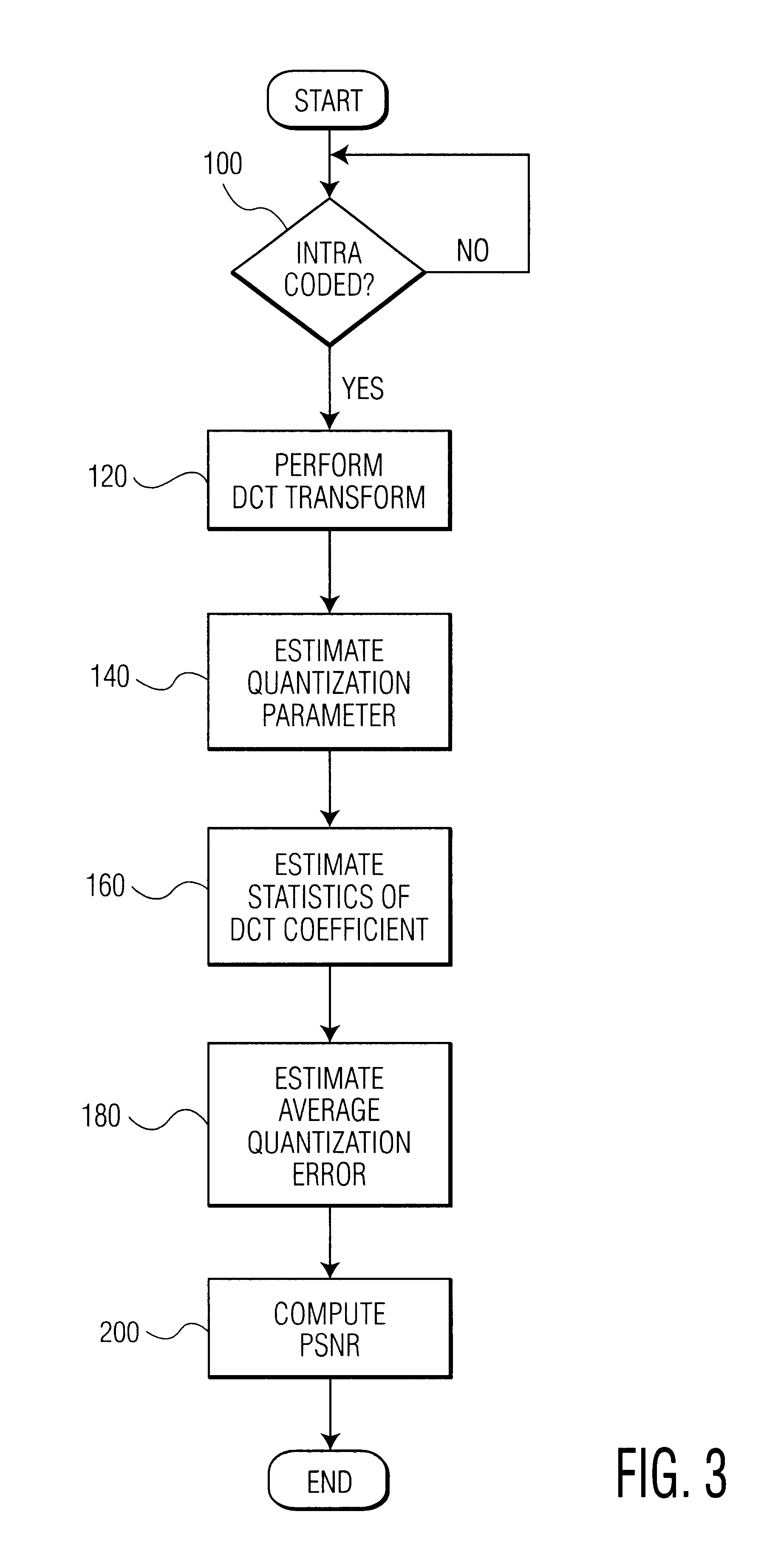Method and system for estimating objective quality of compressed video data
a video data and objective quality technology, applied in the field of method and system for measuring the quality of compressed video data, can solve the problems of inability to access both the processed picture and the source picture, and no single-ended measurement uses the psnr metric in evaluating the compressed picture alon
- Summary
- Abstract
- Description
- Claims
- Application Information
AI Technical Summary
Problems solved by technology
Method used
Image
Examples
first embodiment
FIG. 3 is a flow diagram depicting the operation steps of evaluating video quality in accordance with the present invention. It should be noted that the processing and decision blocks may represent steps performed by functionally equivalent circuits, such as a digital signal processor circuit or an application-specific integrated circuit (ASIC). The flow diagrams do not depict the syntax of any particular programming language. Rather, the flow diagrams illustrate the functional information that a person of ordinary skill in the art requires to fabricate circuits or to generate computer software to perform the processing required of the particular apparatus.
Upon receiving the decoded video output from the decoder 14, an 8.times.8 block DC precision computation is performed by the picture type determinator 20 to determine whether the decoded video is intra-coded for each macroblock in step 100. It is noted that the intra-coded pictures possess unique statistical properties from non-co...
second embodiment
FIG. 4 depicts a representative hardware of the decoder 16 and the estimator 18 illustrated in FIG. 1 according to the present invention. The decoder 16 includes a parser 40, DCT block 42, a statistics collector 44, a distortion calculator 46, and a PSNR calculator 48. In operation, an incoming bitstream is decoded by the decoder 16, and the decoded video data is subjected to DCT processing by the DCT block 42 in order to generate DCT coefficients for AC frequency bands in the video data. The statistics collector 44 estimates variance of the DCT coefficients, whereafter the estimated DCT variance is transmitted to the distortion calculator 46. Meanwhile, the parser 40 extracts quantization matrices from the incoming bitstream that correspond to those used in a previous coding operation. The distortion calculator block 46 uses the quantization matrices and the DCT variance to determine the average quantization error. Finally, the PSNR calculator block 48 determines the PSNR using the...
fourth embodiment
FIG. 7 illustrates the present invention in which the hardware of the estimator is integrated into a conventional decoder. The decoder according to the present invention is a programmable video decoding system, which includes: a variable length decoder (VLD) 60 configured to receive and decode a stream of block-based data packets; an inverse quantizer 62 coupled to receive the output of the VLD 60 to operatively inverse quantize the quantized data received from the VLD 60; an inverse discrete cosine transformer (IDCT) 61 coupled to the output of the inverse quantizer for transforming the dequantized data from a frequency domain to a spatial domain; a motion compensator (MC) 68 configured to receive motion vector data from the quantized data and to generate a reference signal based on motion-compensated block of a preceding frame stored in a preceding frame stage and a motion-compensated block of a succeeding frame stored from a frame storage 70; an adder for receiving the reference ...
PUM
 Login to View More
Login to View More Abstract
Description
Claims
Application Information
 Login to View More
Login to View More - R&D
- Intellectual Property
- Life Sciences
- Materials
- Tech Scout
- Unparalleled Data Quality
- Higher Quality Content
- 60% Fewer Hallucinations
Browse by: Latest US Patents, China's latest patents, Technical Efficacy Thesaurus, Application Domain, Technology Topic, Popular Technical Reports.
© 2025 PatSnap. All rights reserved.Legal|Privacy policy|Modern Slavery Act Transparency Statement|Sitemap|About US| Contact US: help@patsnap.com



